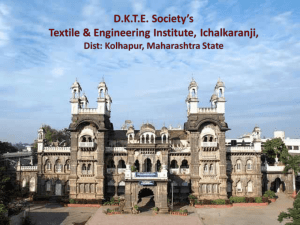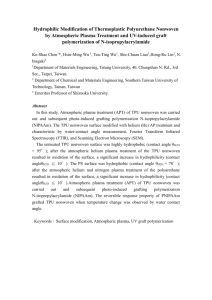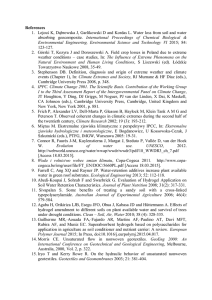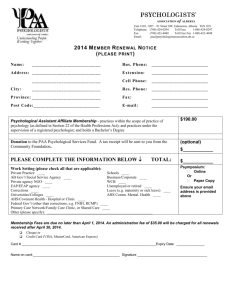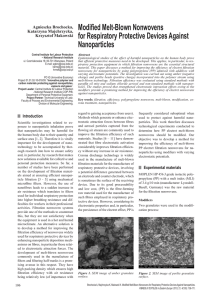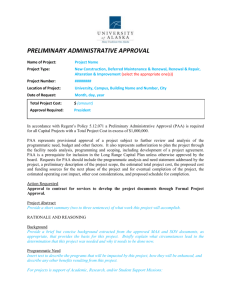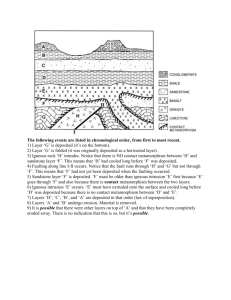Polyelectrolyte Layer-by-Layer Processed Coated Textiles Stefan Połowiński
advertisement
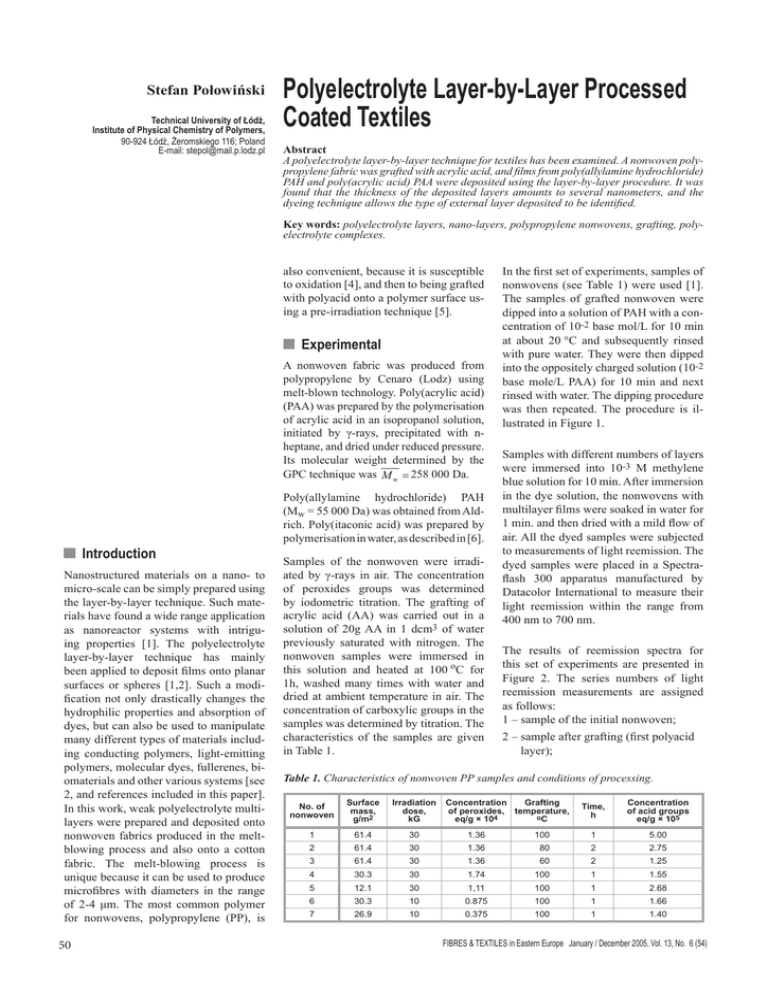
Stefan Połowiński Technical University of Łódź, Institute of Physical Chemistry of Polymers, 90-924 Łódź, Żeromskiego 116; Poland E-mail: stepol@mail.p.lodz.pl Polyelectrolyte Layer-by-Layer Processed Coated Textiles Abstract A polyelectrolyte layer-by-layer technique for textiles has been examined. A nonwoven polypropylene fabric was grafted with acrylic acid, and films from poly(allylamine hydrochloride) PAH and poly(acrylic acid) PAA were deposited using the layer-by-layer procedure. It was found that the thickness of the deposited layers amounts to several nanometers, and the dyeing technique allows the type of external layer deposited to be identified. Key words: polyelectrolyte layers, nano-layers, polypropylene nonwovens, grafting, polyelectrolyte complexes. also convenient, because it is susceptible to oxidation [4], and then to being grafted with polyacid onto a polymer surface using a pre-irradiation technique [5]. n Experimental A nonwoven fabric was produced from polypropylene by Cenaro (Lodz) using melt-blown technology. Poly(acrylic acid) (PAA) was prepared by the polymerisation of acrylic acid in an isopropanol solution, initiated by γ-rays, precipitated with nheptane, and dried under reduced pressure. Its molecular weight determined by the GPC technique was 258 000 Da. n Introduction Nanostructured materials on a nano- to micro-scale can be simply prepared using the layer-by-layer technique. Such materials have found a wide range application as nanoreactor systems with intriguing properties [1]. The polyelectrolyte layer-by-layer technique has mainly been applied to deposit films onto planar surfaces or spheres [1,2]. Such a modification not only drastically changes the hydrophilic properties and absorption of dyes, but can also be used to manipulate many different types of materials including conducting polymers, light-emitting polymers, molecular dyes, fullerenes, biomaterials and other various systems [see 2, and references included in this paper]. In this work, weak polyelectrolyte multilayers were prepared and deposited onto nonwoven fabrics produced in the meltblowing process and also onto a cotton fabric. The melt-blowing process is unique because it can be used to produce microfibres with diameters in the range of 2-4 μm. The most common polymer for nonwovens, polypropylene (PP), is 50 Poly(allylamine hydrochloride) PAH (Mw = 55 000 Da) was obtained from Aldrich. Poly(itaconic acid) was prepared by polymerisation in water, as described in [6]. Samples of the nonwoven were irradiated by γ-rays in air. The concentration of peroxides groups was determined by iodometric titration. The grafting of acrylic acid (AA) was carried out in a solution of 20g AA in 1 dcm3 of water previously saturated with nitrogen. The nonwoven samples were immersed in this solution and heated at 100 oC for 1h, washed many times with water and dried at ambient temperature in air. The concentration of carboxylic groups in the samples was determined by titration. The characteristics of the samples are given in Table 1. In the first set of experiments, samples of nonwovens (see Table 1) were used [1]. The samples of grafted nonwoven were dipped into a solution of PAH with a concentration of 10-2 base mol/L for 10 min at about 20 °C and subsequently rinsed with pure water. They were then dipped into the oppositely charged solution (10-2 base mole/L PAA) for 10 min and next rinsed with water. The dipping procedure was then repeated. The procedure is illustrated in Figure 1. Samples with different numbers of layers were immersed into 10-3 M methylene blue solution for 10 min. After immersion in the dye solution, the nonwovens with multilayer films were soaked in water for 1 min. and then dried with a mild flow of air. All the dyed samples were subjected to measurements of light reemission. The dyed samples were placed in a Spectraflash 300 apparatus manufactured by Datacolor International to measure their light reemission within the range from 400 nm to 700 nm. The results of reemission spectra for this set of experiments are presented in Figure 2. The series numbers of light reemission measurements are assigned as follows: 1 – sample of the initial nonwoven; 2 – sample after grafting (first polyacid layer); Table 1. Characteristics of nonwoven PP samples and conditions of processing. No. of nonwoven Surface mass, g/m2 Irradiation dose, kG Concentration Grafting of peroxides, temperature, 4 oC eq/g × 10 Time, h Concentration of acid groups eq/g × 105 1 61.4 30 1.36 2 61.4 30 1.36 100 1 5.00 80 2 3 61.4 30 2.75 1.36 60 2 4 30.3 1.25 30 1.74 100 1 5 1.55 12.1 30 1,11 100 1 2.68 6 30.3 10 0.875 100 1 1.66 7 26.9 10 0.375 100 1 1.40 FIBRES & TEXTILES in Eastern Europe January / December 2005, Vol. 13, No. 6 (54) Figure 1. Scheme of layer-by-layer technique; PP - polypropylene, AA - acrylic acid, PAH - poly(allylamine hydrochloride), PAA - poly(acryl acid); 1, 2, 3, 4 - the initial surface and the consecutive layers. 3 – samples impregnated with PAH (first layer containing amine groups); 4 – sample impregnated with PAA (second polyacid layer); 5 – samples impregnated with PAH (second layer containing amine groups); 6 – sample impregnated with PAA (third polyacid layer). As seen in Figure 2, the absorption of dye and the related drop in light reemission (especially at 620 nm) only took place when the top layer displayed an acidic character (series 2, 4 and 6). The same procedure was applied in the second set of experiments, using the nonwoven 4 (see Table 1). The application of layers and the dyeing procedure were the same as previously (series 1 and 2). The results of the value corresponding to the minimum of reemission at 620 nm are shown in Figure 3, compared with the results of the first and second series (nonwovens 1 and 4, Table 1). The denotations of samples with the layers applied in succession were the same as in the first set of experiments. As seen in Figure 3, the light reemission for samples with top polyacid layers (series 2, 4 and 6) is considerably lower (by about 30%), while in the case of samples with the PAH layers, the reemission results are comparable with that of the untreated sample (about 70%). The third set of samples was prepared as described previously [6], by depositing a poly(itaconic acid)/poly(ethylene glycol) complex onto a sample of cotton fabric. The application of layers and dyeing procedure were the same as previously (series 1 and 2). Figure 2. Light reemission (R %) spectra of dyed samples (nonwoven 1). 1 - initial nonwoven; 2 - grafted sample; 3 sample with first PAH layer; 4 - sample with second PAA layer; 5 - sample with second PAH layer; 6 - sample with third PAA layer. The results of reemission measurements for the third set of samples are presented in Figure 4. In this case, the absorption of methylene blue was high (reemission 5-7%) for all samples. It leads to the conclusion that the absorption of methylene blue is practically the same as that of the cotton fabric immersed repeatedly in PAH and PAA solutions. n Discussion The grafting process carried out with the use of the pre-irradiation technique can be successfully used to graft acrylic acid onto polypropylene nonwovens. The number of acid groups incorporated due to grafting depends on the dose of irradiation, the grafting temperature and time. It seems that by using an aqueous medium, quite a high temperature and a short time of grafting, the monomer diffusion into filaments is restricted, and the grafting takes place mainly on the nonwoven surface. As follows from the results obtained, the method proposed herein can be used to deposit layers of polymeric complexes onto polypropylene nonwovens, but cannot be applied to porous materials such as cotton fabric. Figure 3. Light reemission R (%) at 620 nm of dyed nonwovens 1 and 4. FIBRES & TEXTILES in Eastern Europe January / December 2005, Vol. 13, No. 6 (54) As seen from Figure 2, the absorption of methylene blue is for the most part confined to the outermost surface layer, with only a limited diffusion of the dye more deeply into the bulk of the multilayer film. From the literature [2], it follows that the thickness of a layer deposited by the technique under discussion is about 5 nm. Thus, with five layers deposited in succession, the total thickness does not exceed 25 nm. Assuming that the fibre has a cylinder shape with an infinitely high length in relation to its radius r, the ratio of fibre surface S to its mass m is: S/m =2/rδ where δ - density of the fibre-forming polymer. If layers with thickness L are deposited onto this surface, the ratio of layer mass to the fibre mass X (or the number of grams of the deposited substance per 1 g of fibre) will be: X= 2Lδw / δ r By substituting 25 nm as an estimated value of the layer thickness, and 3 µm as that of an average fibre radius, we obtain a value of X equal to about 0.016. Figure 4. Reemissions (R%) of dyed cotton samples. 51 Because fine fragments may be detached from the nonwoven during the depositing and rinsing operations, the determination of mass increment by weight is burdened with a high error. Hence the gravimetric method is unsuitable for determining the extent of the substances deposited. However, in all the cases, the mass increment was no higher than 0.01 g/g, which indicates that the thickness of the deposited layers is in fact about several nm. On the other hand, the dyeing technique allows the type of external layers deposited in succession to be identified. It seems that the method proposed can be used to deposit layers of polymeric complexes, not only onto polypropylene nonwovens but also onto other textile materials with a smooth surface, such as polyamide or polyester fibres. This will be a subject of our further investigation. Acknowledgment n The author is grateful to Cenaro (Lodz) for providing samples of polypropylene nonwovens to the Institute of Applied Radiation Chemistry for the irradiation of the samples, and to Dr. Gajdzicki for reemission measurements. n The costs of the scientific work described in this article were covered from the funds on science for the years 2005 - 2007 destined to sponsor the research project Nr 3T08E07029 of the Polish Ministry of Education and Science. References 1. Xiangyang Shi, Mingwu Shen, Helmuth Möhwald; Prog. Polym. Sci., 29 987 (2004). 2. Dongsik Yoo, Seimei S. Shiratori, Michael F. Rubner; Macromolecules 31 4309 (1998). 3. R. Kotra, H. Rong; http//www.apparelsearch.com/education research nonwoven melt blown technology/htm. 4. T. Szreder, M. Wolszczak, J. Mayer; J. Photochem. Photobiol.A: Chemistry 113 265 (1998). 5. E. Turska, S. Połowiński; J. Polym. Sci., Part A 1 2085 (1963). 6. S. Połowiński; Fibres & Textiles in Eastern Europe vol. 12, No. 2 (46) 2004, pp. 84-85. Received 05.06.2005 52 Reviewed 27.10.2005 FIBRES & TEXTILES in Eastern Europe January / December 2005, Vol. 13, No. 6 (54)
